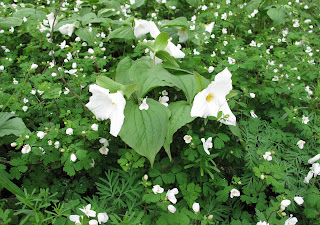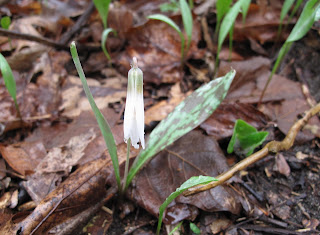Yesterday I looked for what was blooming along two wooded sections of the
The Pumpkinvine Nature Trail - 1.) the section under construction from Elkhart CR 43 east, half-way to LaGrange CR 1150, and 2.) the completed trail near Elkhart CR 33. The woods near CR 33 are more mature and appear to have been less heavily logged and grazed than the woods near CR 43. There are some beech in the CR 33 section, but not at CR 43.
 |
| Beech tree on west side of the trail just south of CR 33 |
 |
| Looking west down the Pumpkinvine from the bridge under construction in section of trail west of CR 43 |
This is the first time I've been to the CR 43 section in the spring. Her is what was blooming 4/26/11:
Spring Beauty -
Claytonia virginica
Round-lobed Hepatica
- Hepatica nobilis var.
obtusa
Bloodroot
- Sanguinaria canadensis It is surprising how many Bloodroot are blooming in late April.
Purple Springcress -
Cardamine douglassi
Spicebush -
Lindera benzoin
Common Blue Violet -
Viola sororia
Yellow Violet -
Viola pubescens
Blue Phlox -
Phlox divaricata
Larged-flowered Trillium -
Trillium grandiflorum Not fully open; many in bud.
Large-flowered Bellwort -
Uvularia grandiflora Many of these relatively uncommon flowers.
 |
| Large-flowered Bellwort Lily Family |
This is the fourth time I've walked the CR 33 section this spring. All of the flowers listed in our April 21 & 17 entries are still blooming. Yellow Trout Lily, Spring Beauty and Common Blue Violet are at their peak.
 |
| Yellow Trout Lily Lily Family |
 |
| Spring Beauty Purslane Family |
 |
| Common Blue Violet Violet Family |
New bloomers as of 4/26/11 are -
Large-flowered Trillium -
Trillium grandiflorum
Blue Phlox -
Phlox divaricata
Buttercup -
Ranunculus species ??
 |
| Large-flowered Trillium Lily Family |
 |
| Blue Phlox Phlox Family |
Below is a most unusual "bloomer" that decorated the trail on 4/26/11!
 |
| Sign propped up on a tree on trail just south of CR 33 |





















































